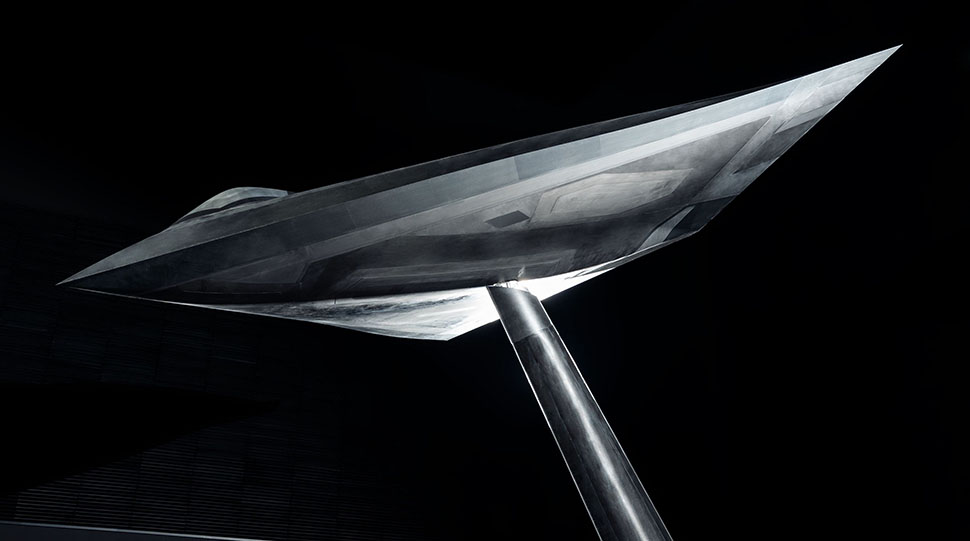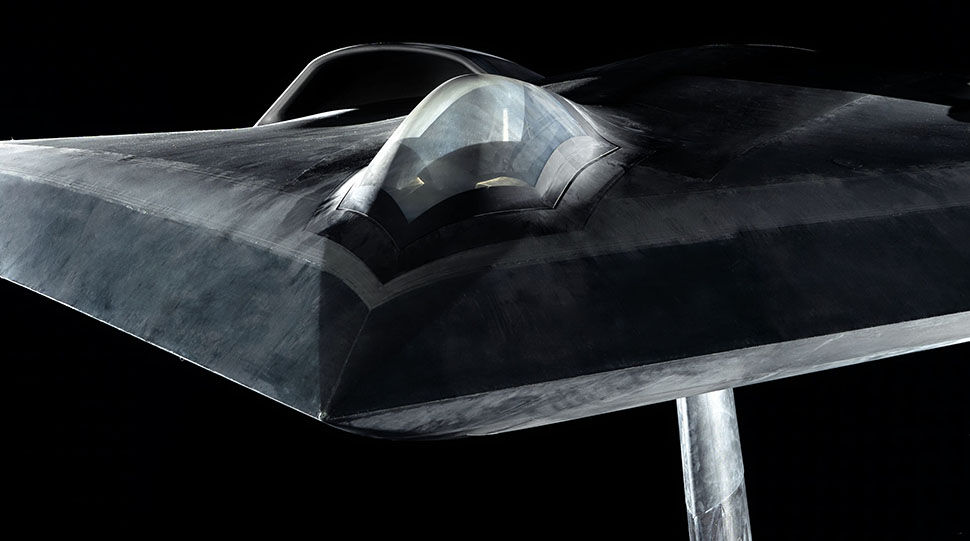Airbus stealth research model/vehicle
- Senior member

- Posts: 457
- Joined: 21 Mar 2008, 04:40
Is the US that far ahead, or on par with the competition?
https://www.thedrive.com/the-war-zone/3 ... eaks-cover
https://www.thedrive.com/the-war-zone/3 ... eaks-cover
You can't shot what you can't see - Unknown
Impressive manned stealth prototype concept, but can they turn it into a deep-strike capability before 2035?
Accel + Alt + VLO + DAS + MDF + Radial Distance = LIFE . . . Always choose Stealth
Airbus reveals LOUT unmanned stealth testbed for Germany
Gareth Jennings, Manching, Germany - Jane's International Defence Review
05 November 2019

The LOUT had been in development since 2007 and was shown to reporters for the first time on 5 November. Source: Airbus
Airbus has revealed a stealth unmanned aerial vehicle (UAV) demonstrator aircraft that it has been developing in secret for over a decade. The Low Observable UAV Testbed (LOUT) was shown to reporters for the first time on 5 November during the company's annual Trade Media Briefing at Manching in southern Germany. Speaking at the unveiling of what remains a classified programme for the German government, Mario Hertzog, German Low Observable (LO) Demonstrator Head, noted the secrecy of the project before providing as much detail as he was permitted.
"Nobody is aware of what we have been doing here - this is a classified project that was started as long ago as 2007. The development contract was awarded in 2010, and the LOUT has been developed in Manching and Bremen in a Skunk Works approach," Hertzog said. Shown to reporters in an anechoic chamber, the LOUT is designed to be a subsonic diamond-shaped LO vehicle that measures 12 m x 12 m (approximately the same size as the BAE Systems Taranis UAV demonstrator from the UK) and weighs four tons. [presumably an empty shape only] It is designed to offer visual, acoustic, radar, and infrared stealth against ground-based threats, indicating that a potential strike role for the technologies is being developed and tested.
The aircraft features an internal weapons bay and all-aspect stealth design features, including radar-absorbing materials, low-radar cross section (RCS) engine inlets, structural cooling technologies, minimised gaps between surfaces, and unspecified LO coatings. With the LOUT optimised to be stealthy against ground-based threats, the intakes are mounted on top of the aircraft. The LOUT also featured a canopy, although Hertzog noted that this was to test the LO properties of the transparency itself for sensor and other applications, rather than to indicate any manned capability for the aircraft. [suggesting they have an air to air variant as well?]
(318 of 517 words)
PICTURES: Airbus reveals classified LOUT stealth testbed
05 November, 2019 SOURCE: FlightGlobal.com BY: Craig Hoyle
Airbus Defence & Space has revealed a more than decade-long research and demonstration effort into very low observable (LO) technologies, conducted as a classified effort for the German defence ministry. Showing its LO UAV testbed – or LOUT – platform at Manching on 4 November, Airbus future combat air system (FCAS) programme manager Mario Hertzog said the company began initial concept work in 2007. This led to a contract award in 2010 to refine configuration and material choices, and the production of a diamond planform demonstrator was completed in 2014. [i.e. German response to the Taranis prototype?]

Airbus
Pointing to the company’s long involvement with LO reseach, Hertzog says: “Bringing all our experience into one programme was a logical conclusion.” The chosen configuration used for aerodynamic and anechoic chamber testing since 2014 has a roughly 12m (39.3ft) wingspan and similar length, and is described as a 4t-class vehicle. The subsonic design would use a conventional engine concealed behind a diverterless inlet, and has twin intakes blended into its upper fuselage. A cockpit transparency and sensor apertures also formed part of the testing. The aircraft's exhaust nozzle also is shielded from beneath, with Hertzog noting that such a vehicle would be optimised for use against ground-based air-defence systems. This mission requirement also led the company to hone LO techniques for the vehicle’s landing gear doors and centerline internal weapons bay, Hertzog notes.

Airbus
Focus areas have included testing LO materials, including a radar absorbent structure for engine intake ducts, and on assessing radar frequency and infrared signature performance. Modelling work has also been conducted to analyse the likely acoustic characteristics of such a design. Airbus confirms that it has completed contracted work on LOUT, but says additional activities could be conducted. However, Hertzog declines to say whether Berlin could seek a flight-test campaign with such a system.
Lessons learned from the LOUT programme will be available for potential adaptation during a long-term evolution activity on the Eurofighter Typhoon, and on a proposed French-German-Spanish FCAS development, Hertzog says. "Stealth is and will remain an enabler for survivability," he notes.

Airbus
So no testing of an actual aircraft.
Gareth Jennings, Manching, Germany - Jane's International Defence Review
05 November 2019

The LOUT had been in development since 2007 and was shown to reporters for the first time on 5 November. Source: Airbus
Airbus has revealed a stealth unmanned aerial vehicle (UAV) demonstrator aircraft that it has been developing in secret for over a decade. The Low Observable UAV Testbed (LOUT) was shown to reporters for the first time on 5 November during the company's annual Trade Media Briefing at Manching in southern Germany. Speaking at the unveiling of what remains a classified programme for the German government, Mario Hertzog, German Low Observable (LO) Demonstrator Head, noted the secrecy of the project before providing as much detail as he was permitted.
"Nobody is aware of what we have been doing here - this is a classified project that was started as long ago as 2007. The development contract was awarded in 2010, and the LOUT has been developed in Manching and Bremen in a Skunk Works approach," Hertzog said. Shown to reporters in an anechoic chamber, the LOUT is designed to be a subsonic diamond-shaped LO vehicle that measures 12 m x 12 m (approximately the same size as the BAE Systems Taranis UAV demonstrator from the UK) and weighs four tons. [presumably an empty shape only] It is designed to offer visual, acoustic, radar, and infrared stealth against ground-based threats, indicating that a potential strike role for the technologies is being developed and tested.
The aircraft features an internal weapons bay and all-aspect stealth design features, including radar-absorbing materials, low-radar cross section (RCS) engine inlets, structural cooling technologies, minimised gaps between surfaces, and unspecified LO coatings. With the LOUT optimised to be stealthy against ground-based threats, the intakes are mounted on top of the aircraft. The LOUT also featured a canopy, although Hertzog noted that this was to test the LO properties of the transparency itself for sensor and other applications, rather than to indicate any manned capability for the aircraft. [suggesting they have an air to air variant as well?]
(318 of 517 words)
PICTURES: Airbus reveals classified LOUT stealth testbed
05 November, 2019 SOURCE: FlightGlobal.com BY: Craig Hoyle
Airbus Defence & Space has revealed a more than decade-long research and demonstration effort into very low observable (LO) technologies, conducted as a classified effort for the German defence ministry. Showing its LO UAV testbed – or LOUT – platform at Manching on 4 November, Airbus future combat air system (FCAS) programme manager Mario Hertzog said the company began initial concept work in 2007. This led to a contract award in 2010 to refine configuration and material choices, and the production of a diamond planform demonstrator was completed in 2014. [i.e. German response to the Taranis prototype?]
Airbus
Pointing to the company’s long involvement with LO reseach, Hertzog says: “Bringing all our experience into one programme was a logical conclusion.” The chosen configuration used for aerodynamic and anechoic chamber testing since 2014 has a roughly 12m (39.3ft) wingspan and similar length, and is described as a 4t-class vehicle. The subsonic design would use a conventional engine concealed behind a diverterless inlet, and has twin intakes blended into its upper fuselage. A cockpit transparency and sensor apertures also formed part of the testing. The aircraft's exhaust nozzle also is shielded from beneath, with Hertzog noting that such a vehicle would be optimised for use against ground-based air-defence systems. This mission requirement also led the company to hone LO techniques for the vehicle’s landing gear doors and centerline internal weapons bay, Hertzog notes.
Airbus
Focus areas have included testing LO materials, including a radar absorbent structure for engine intake ducts, and on assessing radar frequency and infrared signature performance. Modelling work has also been conducted to analyse the likely acoustic characteristics of such a design. Airbus confirms that it has completed contracted work on LOUT, but says additional activities could be conducted. However, Hertzog declines to say whether Berlin could seek a flight-test campaign with such a system.
Lessons learned from the LOUT programme will be available for potential adaptation during a long-term evolution activity on the Eurofighter Typhoon, and on a proposed French-German-Spanish FCAS development, Hertzog says. "Stealth is and will remain an enabler for survivability," he notes.
Airbus
So no testing of an actual aircraft.
Accel + Alt + VLO + DAS + MDF + Radial Distance = LIFE . . . Always choose Stealth
3 posts
|Page 1 of 1
Who is online
Users browsing this forum: No registered users and 2 guests

